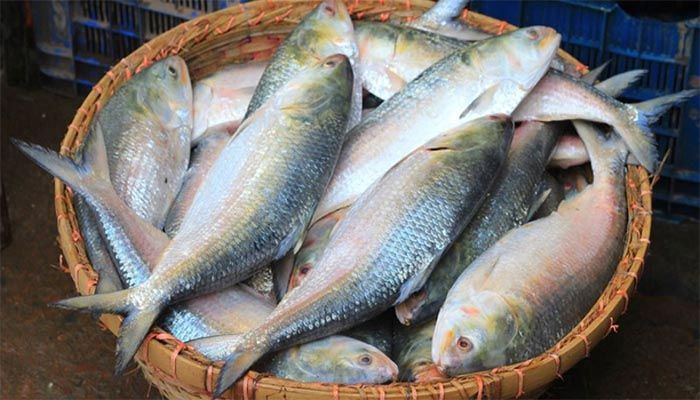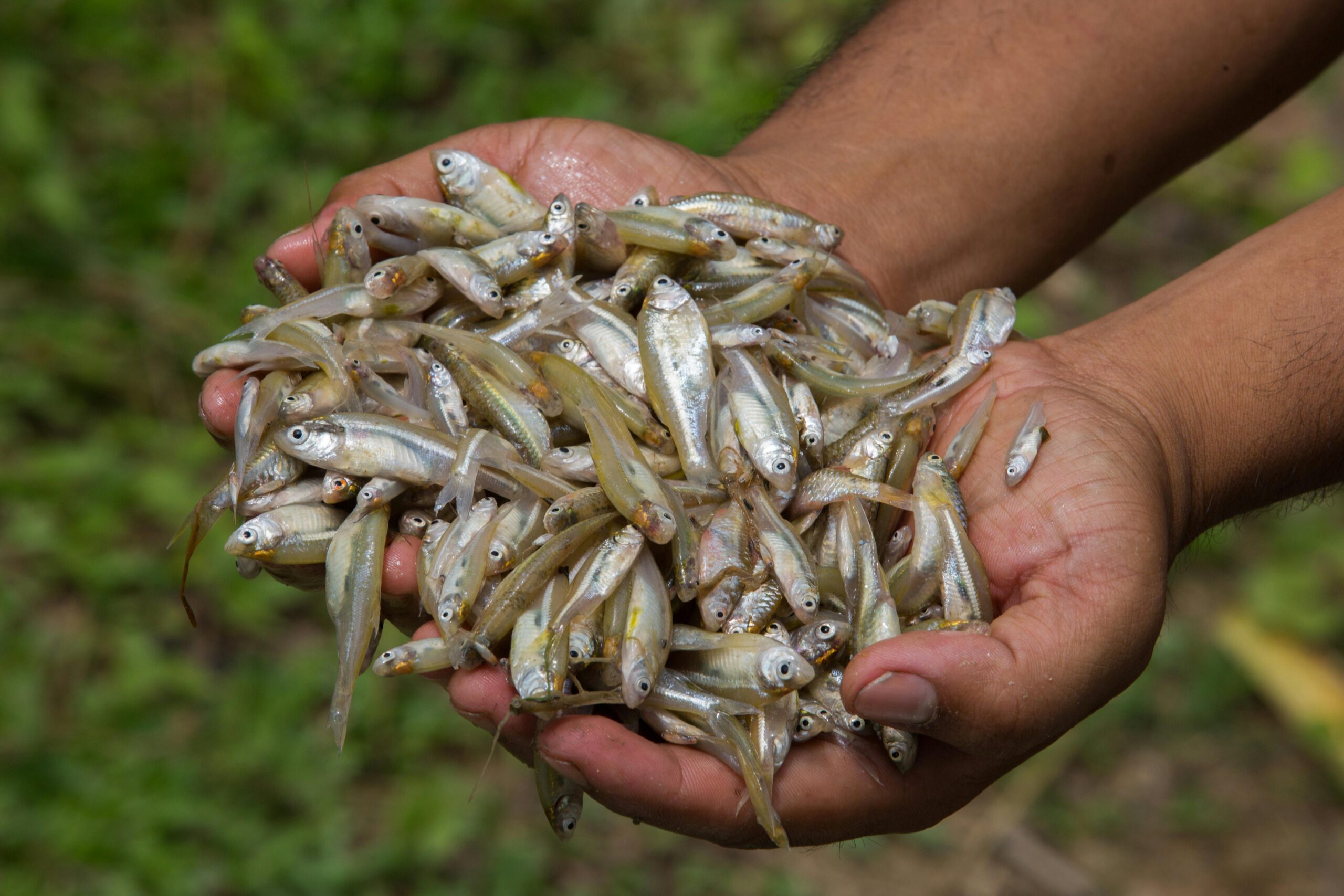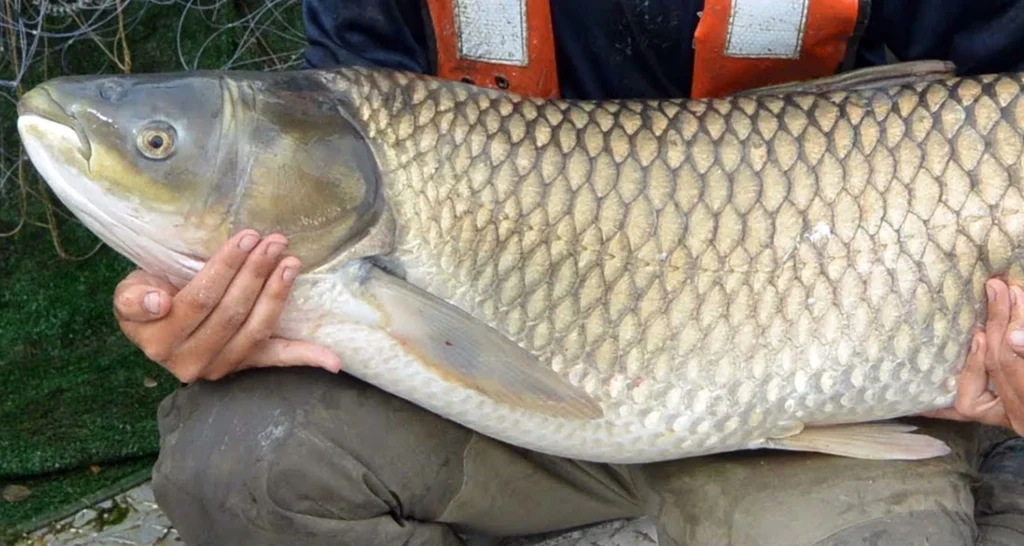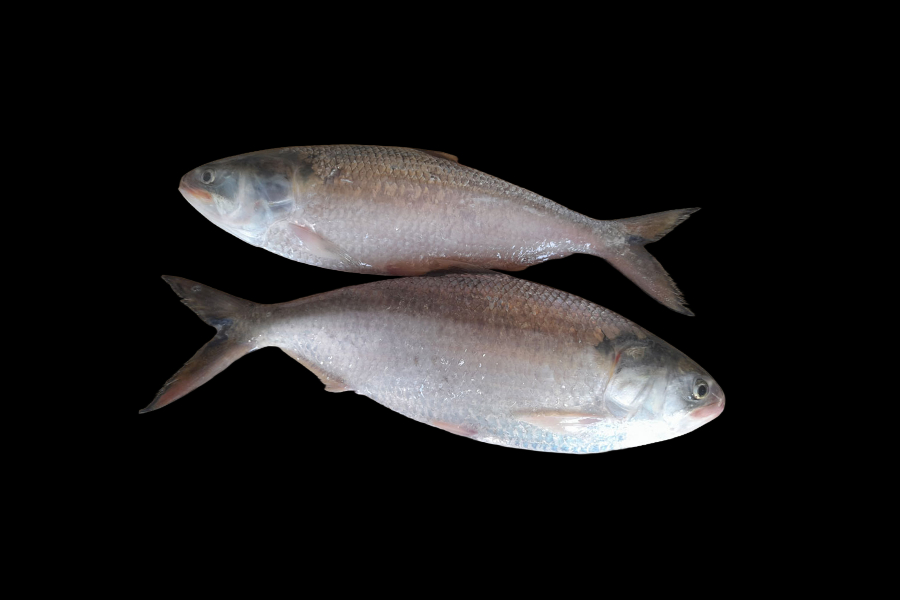River fish thrive in various environments, showcasing remarkable diversity on both regional and international levels. Each region’s rivers are home to unique fish species with distinct characteristics.
Fish Species of Bangladeshi Rivers
The rivers of Bangladesh, such as the Padma, Meghna,jamuna and Brahmaputra, are renowned for their abundant fish species.
Rohu (Labeo rohita): Is one of the most prominent freshwater fish species in Bangladesh and the Indian subcontinent. It is extensively cultivated in the rivers and ponds of Bangladesh and is highly valued for its nutritional benefits and delicious taste. The fish is medium-sized, typically golden or light brown in color, with red-tinted fins. The mouth is slightly flattened, and it has a characteristic line running along its gill plate.
Characteristics:
- Size: Rohu can grow up to 30-35 inches in length, although the size may vary depending on the river or pond. Typically, it weighs around 1-2 kg, but larger fish can reach 4-5 kg or even more.
- Diet: Rohu fish feeds primarily on aquatic plants, algae, and mud. It thrives in the bottom regions of rivers or ponds, where food is abundant and water conditions are favorable for growth.
- Reproduction: Rohu breeds during the monsoon season, typically in open river areas, where it lays eggs. During the breeding season, Rohu exhibits distinctive behavior, and the demand for its farming increases throughout the country.
- Taste & Nutritional Value: Rohu fish has white, tender, and flavorful flesh, which makes it highly popular in culinary use. Its taste is distinct, and it is considered one of the most delicious freshwater fish. Rohu is an excellent source of high-quality protein, vitamin B12, vitamin D, and minerals, making it a nutritious choice for consumers.
Main Uses:
- Food: Rohu is widely used in cooking throughout Bangladesh. It is commonly found in dishes like curry (jhol), steamed (bhapa), fried, or in fish soups.
- Farming: Rohu is farmed extensively in ponds. Its farming is ideal for freshwater aquaculture. It is especially important for pond management, and its presence in ponds ensures good water quality and abundant food resources.
- Commercially: Rohu fish is also exported within and outside the country. Its nutritional value and tender, flavorful flesh have made it a popular choice for international markets.
Rohu’s popularity as a delicious, nutritious fish has made it a significant part of the aquaculture industry in the region and an important dietary staple for millions of people.

Hilsa (Tenualosa ilisha):Is a vital part of Bangladesh’s rich fish culture and is one of the most cherished fish species. Known for its tender, flavorful, and oily meat, Hilsa is widely found in rivers, seas, and coastal areas, particularly around Bangladesh, India, Pakistan, Myanmar, and the Bay of Bengal.
Characteristics:
- Body Structure: Hilsa has a sleek, silvery, or grayish body, and its size can range from medium to large. The fish is rich in oil, contributing to its signature taste and nutritional value.
- Size: Hilsa is typically 2-3 kg, but it can grow up to 4-5 kg or even larger. Larger Hilsa is considered the most desirable for its rich and tender meat.
- Diet: Hilsa feeds on smaller fish, crustaceans, and algae. It generally inhabits the bottom regions of rivers or seas, where it forages for food. This distinct feeding habit sets it apart from other species of fish.
- Reproduction: Hilsa primarily spawns during the monsoon season when it migrates to estuaries or river mouths to lay eggs. The reproduction cycle of Hilsa is crucial, as its population is decreasing, and conservation efforts for sustainable breeding are necessary.
Taste & Nutrition: The flesh of Hilsa is oily, tender, and flavorful. It is a rich source of protein, vitamin D, and omega-3 fatty acids, making it an excellent choice for maintaining heart health, brain function, and overall well-being. Hilsa is also beneficial for skin health and bone strength due to its mineral content.
Main Uses:
- Food: Hilsa is widely popular in Bangladesh and is used in various dishes such as steamed Hilsa (Bhapa Ilish), curry (Ilish Jhol), fried Hilsa, and other regional specialties. It is enjoyed in different cooking styles, from spicy to mild flavors.
- Commercial Importance: Hilsa is commercially significant, particularly for export. It has a huge demand not only in Bangladesh but also in neighboring countries like India and Pakistan. The export of Hilsa contributes substantially to the economy.
- Health Benefits: The omega-3 fatty acids in Hilsa are known to help prevent heart disease and improve brain function. Hilsa is also a great source of essential nutrients such as calcium, phosphorus, and iron, benefiting overall health.
Environmental and Farming Practices: Hilsa farming is commonly carried out in rivers and coastal areas. While Hilsa is naturally found in freshwater and brackish water environments, the appropriate monsoon and sea conditions are critical for its growth. The farming process involves maintaining proper water purification and vegetation in ponds. Some traditional methods of Hilsa farming are still practiced in Bangladesh.
Hilsa’s exceptional taste, health benefits, and commercial value have made it one of the most treasured fish species in the region. Its cultural and dietary significance remains unparalleled.
Catla (Catla catla): Is a large species of freshwater fish commonly found in rivers, lakes, and reservoirs in South Asia. It is extensively found in India, Bangladesh, Pakistan, and Myanmar and is considered an important species for fish farming. Catla is particularly valuable in aquaculture due to its rapid growth and large size.
Characteristics:
- Body Structure: Catla has a broad, round body with a large head and a slender rear part. Its scales are smooth, and it has a silvery color. The fish has two large cheeks that are prominent, contributing to its distinctive look.
- Size: Catla is a large fish and can typically grow up to 2-4 kg. However, under ideal conditions with proper care, it can grow to sizes as large as 10 kg or more.
- Diet: Catla primarily feeds on algae, aquatic plants, small invertebrates, and other aquatic creatures. It generally resides at the bottom of rivers or lakes, helping to maintain clean water. As it matures, it can also prey on other smaller fish.
- Reproduction: Catla’s breeding season typically occurs during the warmer months. It spawns in the upper layers of rivers or lakes, where it lays its eggs. The breeding process is crucial as a suitable environment must be maintained for the fish to produce healthy offspring. Catla is also farmed in controlled aquaculture environments for reproduction.
Taste & Nutrition: Catla fish has tender, flavorful meat that is prized for its mild taste and rich texture. It is high in protein, vitamin B12, iron, and selenium, which contribute to improving the immune system and building strong muscles. The meat is also low in fat, making it a healthy option for heart health.
Main Uses:
- Food: Catla is widely consumed in Bangladesh and other South Asian countries. It is used in various dishes such as fish curry, steamed Catla, fried Catla, and other regional specialties.
- Commercial Use: Due to its high production rates and ease of farming, Catla is a commercially important fish species. It is widely farmed in ponds, lakes, and reservoirs for domestic consumption and export.
- Health Benefits: Catla’s high protein and mineral content helps maintain cardiovascular health, strengthen muscles, and regulate blood sugar levels.
Environment & Farming:
Catla is commonly farmed in rivers, lakes, and large ponds. It thrives in environments where the water has optimal temperature, pH, and oxygen levels. Aquaculture practices ensure that proper conditions are maintained, with attention to the growth of aquatic plants in the farming area. Catla’s adaptability and rapid growth make it a suitable candidate for large-scale farming operations.
Catla’s rich taste, nutritional benefits, and commercial value have made it a preferred fish species in South Asia, especially for both local consumption and export.
Prawns (Macrobrachium rosenbergii):Also known as giant freshwater prawns, is a significant species of freshwater prawn found in rivers, lakes, and ponds across Southeast Asia. It is one of the most widely farmed species in countries like Bangladesh, India, Thailand, Myanmar, Vietnam, and Pakistan, where its aquaculture is highly valued. This species is known for its commercial importance and is extensively farmed for food consumption and export.
Characteristics:
- Body Structure: Prawns have a long, slender body with a tough exoskeleton. They feature a large head with two long antennae. The color of the prawn is generally white or silver, but it can change depending on the water conditions and environment.
- Size: Prawns are generally medium to large in size. They typically grow to about 25-30 cm, but some individuals can reach over 40 cm. The weight of a prawn can range from 300 to 500 grams, with some large specimens exceeding 1 kg.
- Diet: Prawns feed on algae, aquatic plants, small crustaceans, and other tiny aquatic creatures. They usually scavenge at the bottom of rivers or ponds to find food, depending on the water environment.
- Reproduction: The breeding season for prawns typically occurs during the warmer months. They breed in estuaries or sea waters where the female prawns lay their eggs. After fertilization, the larvae develop in freshwater environments. Proper breeding management is essential in aquaculture for healthy prawn production.
Taste & Nutrition: Prawn meat is highly sought after for its tender texture and delicious taste. It is rich in protein, vitamin B12, iron, and selenium, which contribute to overall health, immune system support, and muscle strength. The meat is low in fat, making it heart-healthy and effective in maintaining good blood circulation. Prawns also have a high concentration of antioxidants and essential minerals.
Main Uses:
- Food: Prawns are widely used in a variety of dishes, including prawn curry, prawn fry, prawn kebabs, soups, and other seafood recipes. The delicate and succulent meat is enjoyed in various culinary preparations.
- Commercial Use: Prawns are extensively farmed for commercial purposes. Due to the high demand and production rates, prawn farming has become a key industry in many countries. The export market for prawns is significant, contributing to the economy of these countries.
- Health Benefits: Prawns are a great source of high-quality protein and essential minerals that help maintain heart health, promote healthy blood flow, and strengthen muscles. Their nutrient-dense composition also aids in boosting immunity and supporting overall wellness.
Environment & Farming: Prawns are typically farmed in freshwater ponds and rivers where water quality is carefully monitored for temperature, pH, and oxygen levels. They can be farmed in natural water bodies, but most commercial farming takes place in controlled aquaculture systems. Proper management of water cleanliness and light conditions is essential for healthy prawn farming.
Prawns’ excellent taste, nutritional value, and commercial importance make them a highly desirable species for aquaculture and a popular seafood choice globally.
Shrimp:There are various species of shrimp found in different rivers, seas, and coastal regions around the world. Among these species, some are popular while others are less known, but all are recognized for their nutritional and economic importance.
1. Black Tiger Shrimp (Penaeus monodon):
- Characteristics: The Black Tiger Shrimp is one of the largest shrimp species found in the ocean. Its body is sturdy, with a golden or light brown hue.
- Size: It typically grows up to 25-30 cm in length.
- Habitat: It is mostly found in brackish water or saltwater regions, especially in coastal areas.
- Farming: Black Tiger Shrimp farming requires a special environment, and it is commonly farmed in coastal areas of Bangladesh, with a focus on export.
2. Giant Freshwater Prawn (Macrobrachium rosenbergii):
- Characteristics: This is a large freshwater prawn species. Its body is long and powerful, with a color range from white to pink.
- Size: It can grow up to 30-35 cm in length.
- Habitat: Found in rivers, ponds, and coastal regions, some of these prawns can even thrive in brackish waters.
- Farming: Proper water quality and environmental conditions are essential for farming this prawn. It is widely farmed in Bangladesh’s coastal areas.
3. Indian White Shrimp (Penaeus indicus):
- Characteristics: The Indian White Shrimp is smaller in size with a golden or brownish body color. It is mostly found in the ocean.
- Size: It grows up to 20-25 cm.
- Habitat: It is found primarily in coastal areas of the sea.
- Farming: This shrimp is farmed in some coastal areas of Bangladesh.
4. Gurra Shrimp (Metapenaeus dobsoni):
- Characteristics: Gurra Shrimp is a smaller species of shrimp found in both saltwater and freshwater regions. It is widely known for its small size.
- Size: It typically grows up to 15-20 cm.
- Habitat: Found in both ocean and coastal areas.
- Farming: Gurra Shrimp is farmed in smaller water bodies in Bangladesh’s coastal regions.
5. Green Tiger Shrimp (Penaeus semisulcatus):
- Characteristics: The Green Tiger Shrimp is a valuable species, known for its golden or slightly greenish color.
- Size: It grows around 18-25 cm in length.
- Habitat: It is found in saltwater regions, primarily around the ocean.
- Farming: Green Tiger Shrimp farming is common in the coastal regions of Bangladesh and plays a significant role in exports.
Conclusion:
The various shrimp species mentioned above play a significant role in the aquaculture industry, especially in countries like Bangladesh. With their high nutritional value and export potential, shrimp farming has become a key economic activity. These species are farmed in both freshwater and saltwater regions, with each species having its unique characteristics and farming requirements.
Pangasius Fish is a popular freshwater fish, widely farmed in the rivers and ponds of Bangladesh. It is found in the rivers of Southeast Asia, especially in the Mekong and Chao Phraya rivers. Pangasius fish has distinctive features, nutritional benefits, and farming techniques that set it apart from other fish species.
Characteristics:
- Size: Pangasius fish can grow up to 1 meter in length and weigh around 20 kilograms.
- Body Shape: It has a wide and elongated body, with a big head and its color is usually white to light brown or silver.
- Habitat: Originally native to Southeast Asian river systems, it is now farmed in many parts of the world. Its soft and delicious flesh makes it highly popular.
Farming:
- Pangasius is typically farmed in deeper waters. It requires fresh and clean water, although it can also thrive in slightly brackish water.
- In Bangladesh, areas like Chittagong, Khulna, Barisal, and Kishoreganj are known for large-scale Pangasius farming.
Diet:
- Pangasius fish is omnivorous, meaning it feeds on both plants and animals. It generally consumes small fish, aquatic animals, and various aquatic plants.
Economic Importance:
- Pangasius farming plays a significant role in Bangladesh’s aquaculture industry. Its flesh is exported, contributing to the national economy. Additionally, it is in high demand in local markets due to its affordability and taste.
Conclusion:
Pangasius fish is a key player in both local and international markets, thanks to its adaptability, taste, and farming efficiency. It not only provides a sustainable source of income for local farmers but also contributes significantly to the country’s export economy.




